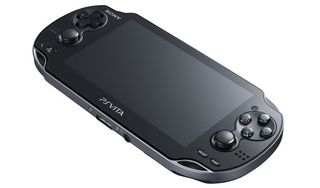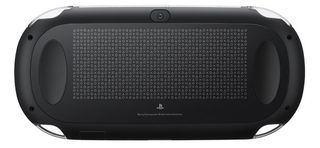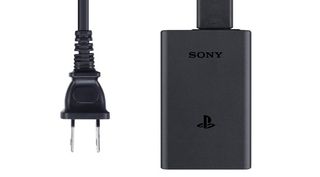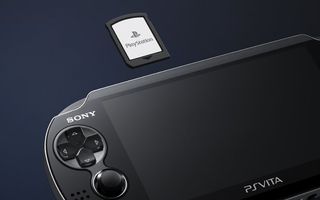How do the PS Vita's specs stack up against the competition?
A look at the handheld's graphics, battery life, controls, and memory, what they mean to gamers, and how its competitors measure up
Controls
Vita has: Capacitive front touch display and rear touch panel, Sixaxis motion controls, dual analog sticks, directional pad, and six input buttons

Like the iPhone 4S and many current smartphones, the Vita's screen is a capacitive multi-touch display, which channels the electrical current in the human body for smooth and precise touch input from multiple fingers all around the screen. The Nintendo 3DS touchscreen, on the other hand, utilizes the same resistance touch technology as the original Nintendo DS. It's a much cheaper type of touchscreen that requires a harder input and supports much lower contrasts, due to the multiple layers visible beneath the outer screen that activate when pressed together.
On the Vita, the multi-touch screen is used for everything from navigating through the system and game menus to controlling actual games, much like you might a smartphone game. However, the rear touch panel is something very new: it's essentially a touchscreen without a visible display. It's used to add a subtle new layer of interactivity to select games, such as the ability to rub the panel to climb ladders in Uncharted: Golden Abyss through swipes of the screen, or effectively pass the ball in FIFA Soccer without blocking the front screen with your hand.

Sony's Sixaxis motion-control system from the PlayStation 3 is included in the Vita, which includes a three-axis gyroscope and three-axis accelerometer for controlling games through physical movements of the hardware. It's ultimately quite similar to the tech seen in both the Nintendo 3DS and iPhone 4S, though, despite Sony using its own name for the feature. And like on the 3DS and PSP, the Vita includes a directional pad and six input buttons (four face buttons and two shoulder ones), but luckily features twice the analog sticks of any gaming handheld to date. Both analog sticks are notably raised higher than the nubs on the PSP and 3DS, and the second stick will come in handy for controlling shooters and action games, in particular.
The battery
Vita has: 2210 mAh battery, rated at 3-5 hours

Above: Get ready to use this thing a lot
While the 2210 mAh battery found in the PlayStation Vita is larger in capacity than many current smartphones, the hardware absolutely drains the little power cell, offering about three to five hours of gameplay on a full charge. This falls in line with the Nintendo 3DS, which offers a similar number of hours on a smaller 1300 mAh capacity battery pack. Comparatively, the iPhone 4S offers a 1432 mAh battery that offers about 10 hours of consistent play (depending on usage).
Sign up to the 12DOVE Newsletter
Weekly digests, tales from the communities you love, and more
The original PSP model came packed with an 1800 mAh battery, while later models scaled it down to 1200 mAh, but all offered a similar range of four-to-six hours of gameplay. However, a larger (and optional) 2200 mAh extended battery for the later models significantly increased that tally.
Storage
Vita has: Memory cards up to 32GB

Above: As expensive as they are, they're also tiny. Careful you don't swallow yours accidentally
Looking to store game saves, downloaded games and demos, and various other media on the PlayStation Vita? You'll need to invest in one of Sony's proprietary memory cards, which range from 4GB ($20) to 32GB ($100) in size. With a retail-sized downloadable game like Uncharted: Golden Abyss weighing in at 3.2 GB, plus music and movies sure to eat up significant space, heavy users may want to bite the bullet and aim high on the storage ladder. Then again, those prices are sure to tumble with time.
The PSP utilizes Sony's Memory Stick Duo storage format, which eventually reached 32GB capacity models after much smaller initial sizes. The PSPgo, on the other hand, shipped with internal storage of 16GB and supported Memory Stick Micro cards up to 32GB for additional storage. Nintendo's 3DS includes 1.5GB of usable internal storage for game saves and downloads, and also comes with a 2GB SD card – but you can use SDHC cards up to 32GB for much greater storage. Apple's iPhone 4S relies entirely on internal storage, but while the entry-level version offers just 16GB of space, the number is quadrupled in the 64GB iteration.
Media format
Vita has: Proprietary game cards with 2GB-4GB capacity

The PlayStation Vita's primary format is Sony's own PlayStation Vita card, a tiny, flash memory-based stick that currently offers either 2GB or 4GB of space for developers to work with. Larger-capacity sticks are expected down the line, and of course, games are also available for download from the PlayStation Store. While game size cannot be tied directly to quality, bigger games usually include more or higher-resolution art assets, along with potentially larger environments and a greater reliance on video footage. This may also explain why Uncharted: Golden Abyss – which uses the 4GB card – is priced higher than other Vita launch games, most of which seem to fit on the smaller cards.
The 3DS uses similarly sized cartridges that range from 128MB to 4GB in size, while the iPhone 4S relies entirely on downloads, which range spectacularly from a megabyte or so to nearly 2GB for the largest game. And while the PSP supports downloadable games, its primary format is the UMD (Universal Media Disc), which offers up to 1.8GB of storage on a small disc inside a plastic case. The PSPgo model supports only downloadable games, though.
Cameras
Vita has: Front and back cameras at 640x480 (0.3 megapixels)

The PlayStation Vita offers front and back cameras that can be used to snap photos, shoot video clips, or videoconference with pals. Additionally, the cameras can be utilized in augmented reality games (as seen in Little Deviants), in which the world around you becomes part of the game. Both are standard VGA cameras, which offer a resolution of just 640x480, or 0.3 megapixels – a pretty small number, but these aren't meant to supplant dedicated cameras.
The Nintendo 3DS features three cameras, two of which are on the back and work together to create 3D images; but all three feature the same resolution as the Vita cameras. The front camera of the iPhone 4S – primarily meant for video calls – is similarly rated, but the back camera is comparable to common point-and-shoot digital cameras, offering 8-megapixel images and the ability to shoot 1080p HD video.

Avowed lead isn't worried about launching between Assassin's Creed Shadows and Monster Hunter Wilds because you're never "going to find a window where absolutely nothing is coming out"

Borderlands 3 creative director says he left Gearbox partly because creativity can get stifled on 400-person teams: "There'd be great design ideas that would never bubble up to the top"
Most Popular

